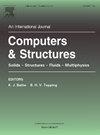在特征荷载空间中构建结构性能包络的高效方法
IF 4.4
2区 工程技术
Q1 COMPUTER SCIENCE, INTERDISCIPLINARY APPLICATIONS
引用次数: 0
摘要
性能包络提供了一种新颖的方法,可量化结构在缩小尺寸载荷空间中的承载能力。包络线将作用在结构上的复杂载荷与相应的结构失效约束联系起来,可广泛应用于飞机结构设计过程中。为工业问题构建包络线尤其引人关注,最先进的实施方法包括点云网格划分和表面建模策略。在工程流程中实施包络的一个主要挑战是构建包络的相关计算成本较高。本文的贡献在于提出了一种稳健高效的策略,以降低构建性能包络线的计算成本。本文介绍了一种使用射线缩放方法构建包络线的方法。通过为具有代表性的工业问题(AIRBUS XRF-1 机翼的加劲板)构建三维包络线,验证了这种新方法。结果表明,与之前的研究相比,计算成本降低了 42%。施工效率的提高使得在大型工业生产过程中,或在单个故障评估计算成本较高的情况下,采用包络法更加可行。本文章由计算机程序翻译,如有差异,请以英文原文为准。
Efficient methods to build structural performance envelopes in characteristic load space
Performance envelopes provide a novel methodology that quantifies the load bearing capacity of a structure in a reduced dimension load space. The envelopes relate the complex loads acting on a structure to the corresponding structural failure constraints and may find many applications within the aircraft structural design process. Constructing envelopes for industrial problems is of particular interest, where the state-of-the-art implementation involves a point cloud meshing and surface modelling strategy. A main challenge in implementing envelopes within an engineering process is the large associated computational costs of construction. The contribution of this article is a robust and efficient strategy to reduce the computational costs of building a performance envelope. The paper presents a method to build the envelopes using a ray-scaling approach. The novel approach is validated by building 3-dimensional envelopes for a representative industrial problem (stiffened panels of AIRBUS’s XRF-1 wing). The results demonstrate a ∼ 42 % reduction in the computation costs compared to the preceding research. The improved construction efficiency makes the employment of envelopes more feasible for large industrial scale processes or when individual failure assessments are computationally expensive.
求助全文
通过发布文献求助,成功后即可免费获取论文全文。
去求助
来源期刊

Computers & Structures
工程技术-工程:土木
CiteScore
8.80
自引率
6.40%
发文量
122
审稿时长
33 days
期刊介绍:
Computers & Structures publishes advances in the development and use of computational methods for the solution of problems in engineering and the sciences. The range of appropriate contributions is wide, and includes papers on establishing appropriate mathematical models and their numerical solution in all areas of mechanics. The journal also includes articles that present a substantial review of a field in the topics of the journal.
 求助内容:
求助内容: 应助结果提醒方式:
应助结果提醒方式:


